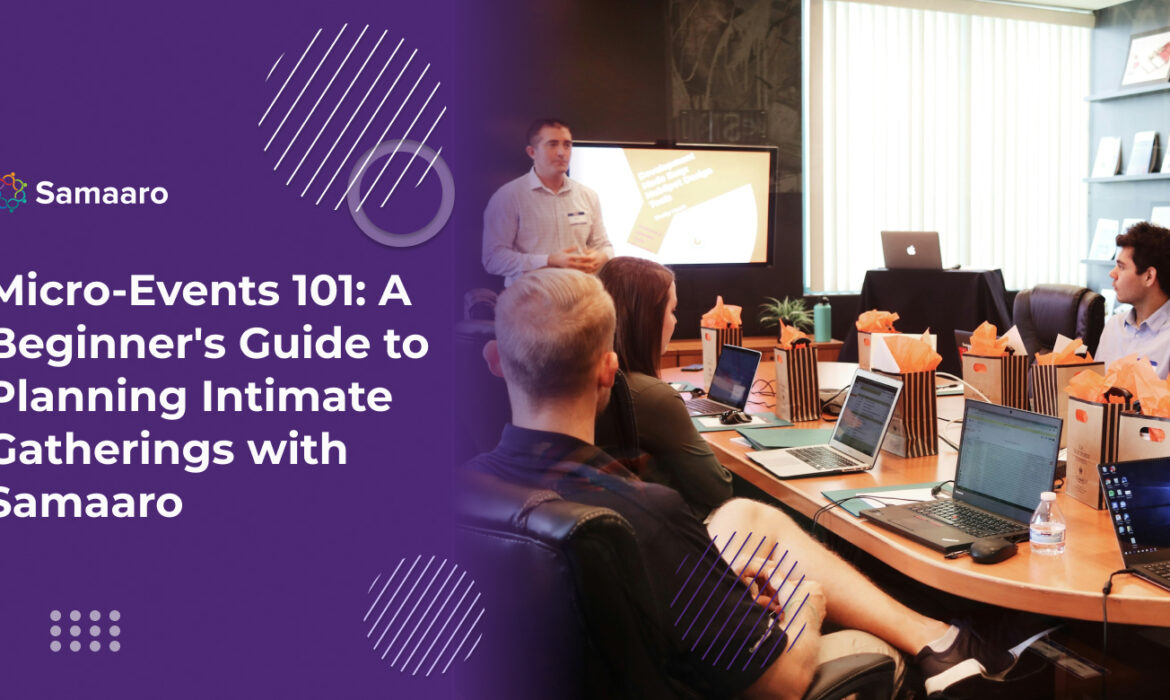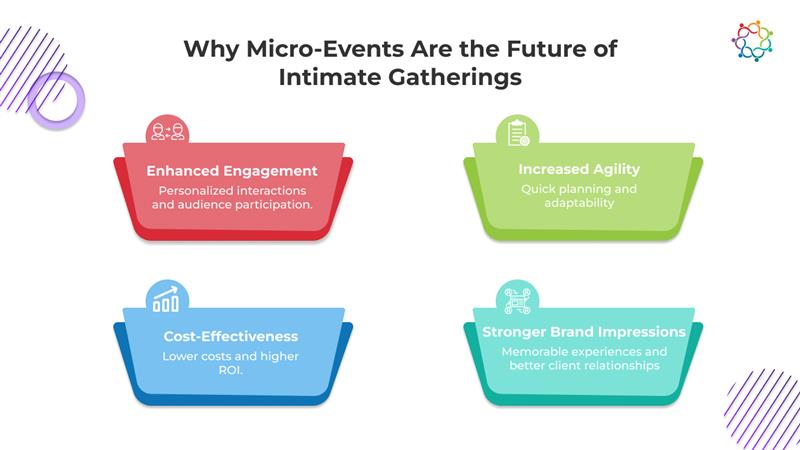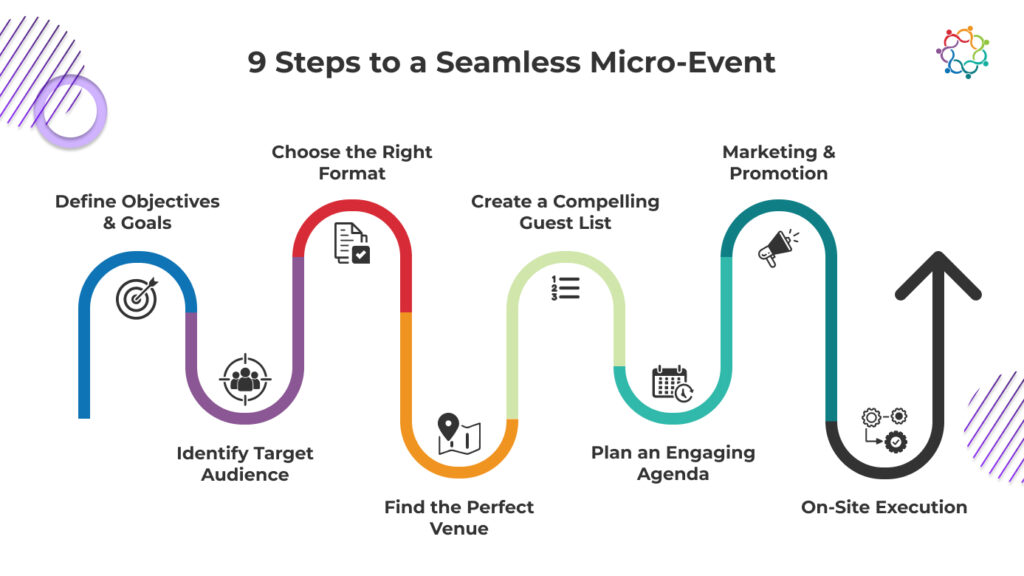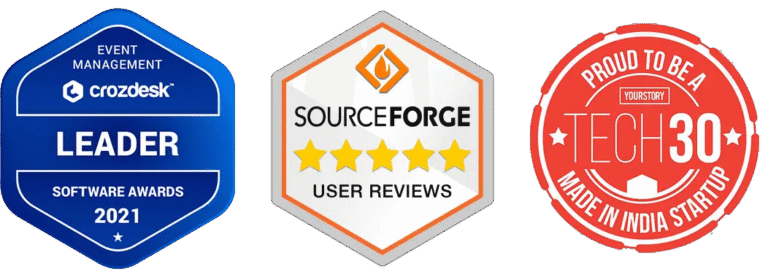Samaaro + Your CRM: Zero Integration Fee for Annual Sign-Ups Until 30 June, 2025
- 00Days
- 00Hrs
- 00Min

Micro-events are becoming an increasingly common business event in the age of after-event engagement where experiences are recognized as stronger touchpoints for building relationships between brands and audiences. A micro-event is often a viable alternative to a large (and costly) conference or trade show. Micro-events are often smaller events where you can provide more personalization to guests based on their interests, which could promote a deeper connection between a brand and audience.
Micro-events are essentially a smaller way to engage your audience without the headache of planning and arranging for a large audience. Samaaro, an AI-powered event marketing platform provides event-led organizations with the ease to plan, execute, and measure micro-events. In this article, we will explore the advantages of micro-events, as well as, how to plan a micro-event that your guests will remember.

The first major benefit of micro-events is the ease of having better engagement in general. With fewer guests, you have a higher chance of having a genuine one-on-one interaction with attendees. When guests are in a smaller and friendlier atmosphere, they are much more likely to share their opinions, provide meaningful feedback, or engage in discussions either with the host or with other guests that could eventually lead to greater audience involvement and more significant opportunities, partnerships, or larger-scale sales or promotions.
Micro-events often involve a much lower cost compared to a larger conference or trade show. With a more selective guest list, costs related to venue rental, food and beverage, and tabling or event materials can all be lowered. With micro-events, the ability to be more selective with your guest list means your budget can be focused on your highest-value targets and a return on your investment. Using Samaaro’s target marketing and audience segmentation tools, you can be certain that your marketing efforts are directed at the most relevant prospects to maximize your ROI.
Another distinct advantage of micro-events is the enhanced flexibility they come with. Unlike large scale events, which take months of preparation, micro-events can usually be created and executed in a shorter time. A networking dinner? A product demonstration? Micro-events are suitable for smaller groups and both can be arranged to take place faster than the larger event. The smaller scale provides increased flexibility when making decisions and pivoting when necessary.
It’s widely accepted that micro-events offer more opportunities to create lasting brand impressions – because they are more personal and interactive, brands can demonstrate the product or service in a fuller and more engaging context. Attendees have stronger, and greater, connections to the brand, building loyalty and advocacy. Samaaro’s event marketing tools will also help you to create unique experiences that helped to differentiate your brand and leave a lasting impression!

The first step to planning any successful event is to define your objectives. What do you hope to achieve from this micro-event? Each of these micro-events could involve networking opportunities, product launches, team-building events, and client appreciation, but your goals should also fit your business objective. Using the SMART framework of specific, measurable, but achievable, relevant and time-bound goals, let’s prepare some clear outcomes from the event.
Understanding your audience is important for the success of your micro-event. With a smaller audience, you should be more intentional with attendees that participate in your event. Who can benefit from your event? Potential clients? Influencers? Employees? Partners? Samaaro has audience segmentation tools with features that allow you to find the right invitees, people who are going to get the most value with the event.
Micro-events can take on several different forms, like intimate dinners, product demos, appreciation events or networking workshops, and your format should align with your goals. If your goal is to show off a new product, for example, this is best done through a hands-on demonstration, but if you are connecting with a few key clients, a private dinner would be much more appropriate. Samaaro helps you create the right event format for your objectives.
The venue is going to set the tone for your micro-event. Look for some intimate, unconventional venue that matches the spirit and scale of your event! Private residences, galleries, upscale restaurants and boutique hotels all represent good options for micro-events. Samaaro’s venue sourcing tools allow you to find the best fit for your gathering that fits your vision.
Guest lists matter with micro-events. Because the event is small, every person matters. When you are ready to manage your guests, use Samaaro’s CRM integration to manage your guests’ data, personalize your invite, and track RSVPs. It is also important to follow the steps to pick the right people who will add value to the event and align with your perfect attendee profile.
An engaging agenda will ensure your micro-event is a success. With a small group, there is an opportunity to have an agenda that engages and connects the group. You can add interactive events, discussions, or even surprise events. Think about what will engage your audience and create an unforgettable experience. Samrao can even assist in streamlining with tools for scheduling and managing attendance engagement with each event.
Despite being small, micro-events still demand promotional efforts. Indeed, all the communication tools in your marketing toolbox will help get people to attend your micro-event; personalized emails, promotional posts on social media, and emails directly asking to join the event will all entice your target audience. Samaaro has the marketing automation tools to design, set up, and execute well-targeted marketing campaigns to promote your event to new people with maximum exposure and reach. You can easily segment your audience to make sure that your messaging attracts the right attendees.
Event success often rests on executing a perfect event. You need to check-in guests, herd and manage a bunch of heads, direct foot traffic, and everything else should click together seamlessly. Samaaro’s event management product allows you to manage a small event on-site, and once you start, you only have to worry about the logistics for the event to go off without a hitch. Once the micro-event is over, Samaaro allows you to gather real-time feedback from attendees so you can action any improvements for the future.
Follow up after the event to continue to build on any relationships formed. Send your guests a personal email thanking them for attending, sharing some recognized events of the event, and following up with any leads or business opportunities. Samaroo provides analytics tools to gather valuable insights from your micro-event. You can gather your attendee engagement data and their general feedback to adjust and evolve your next engagement.
Micro-events are a great way to establish stronger relationships with potential clients and provide exciting brand experiences. By planning and executing smaller excited gatherings, companies can enhance engagement and brand impressions, while driving higher ROI. Samaaro has all our micro-event products to plan, market, and evaluate your micro-event ensuring there is impact and engagement.
Samaaro is a simple solution that can streamline the entire event process – audience segmentation, sourcing venues, event planning, marketing automation, and post event follow up. Interested in planning your next micro-event? Book a demo of Samaaro today and find out how we can help you plan successful high-impact events.

Built for modern marketing teams, Samaaro’s AI-powered event-tech platform helps you run events more efficiently, reduce manual work, engage attendees, capture qualified leads and gain real-time visibility into your events’ performance.


© 2025 — Samaaro. All Rights Reserved.